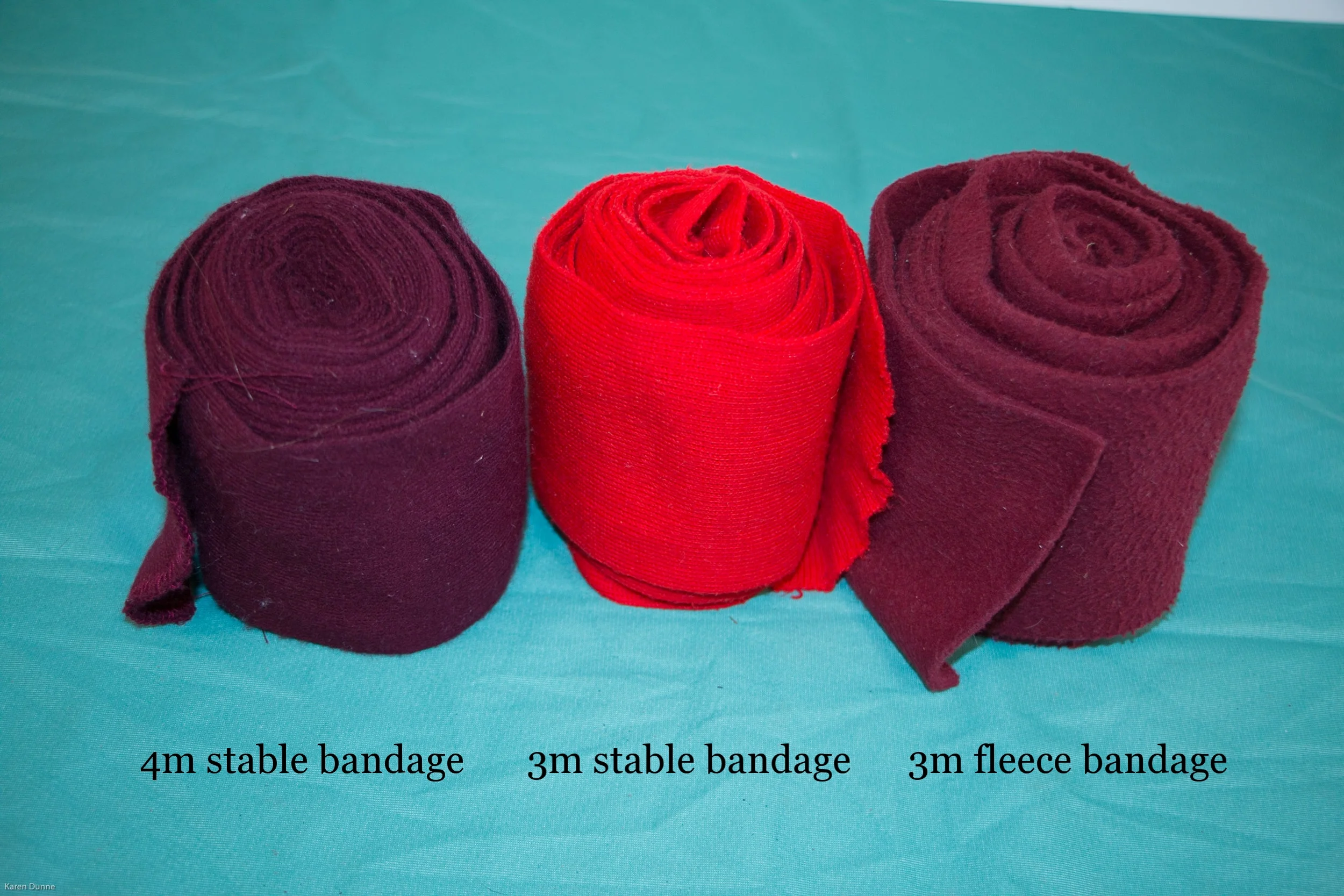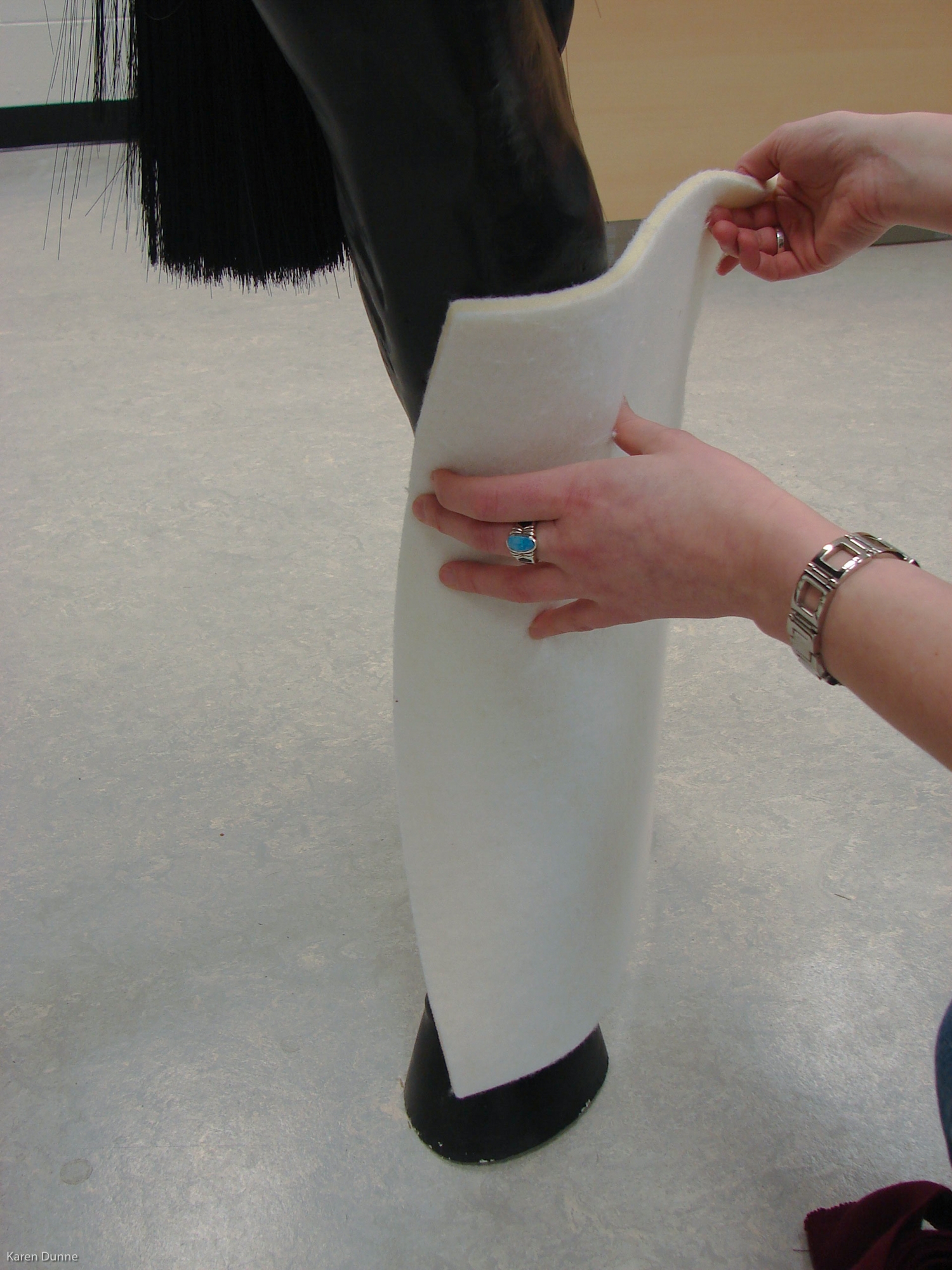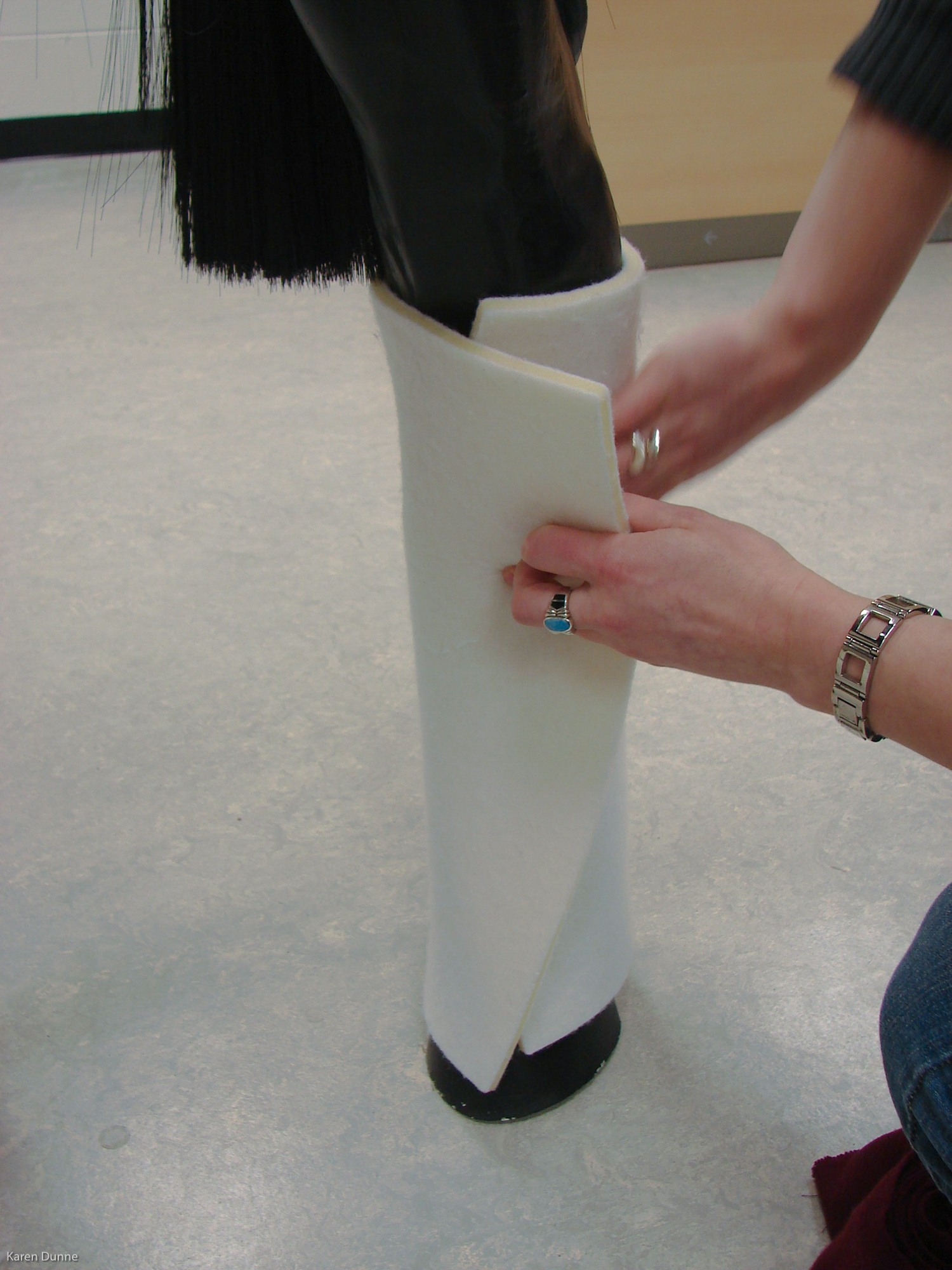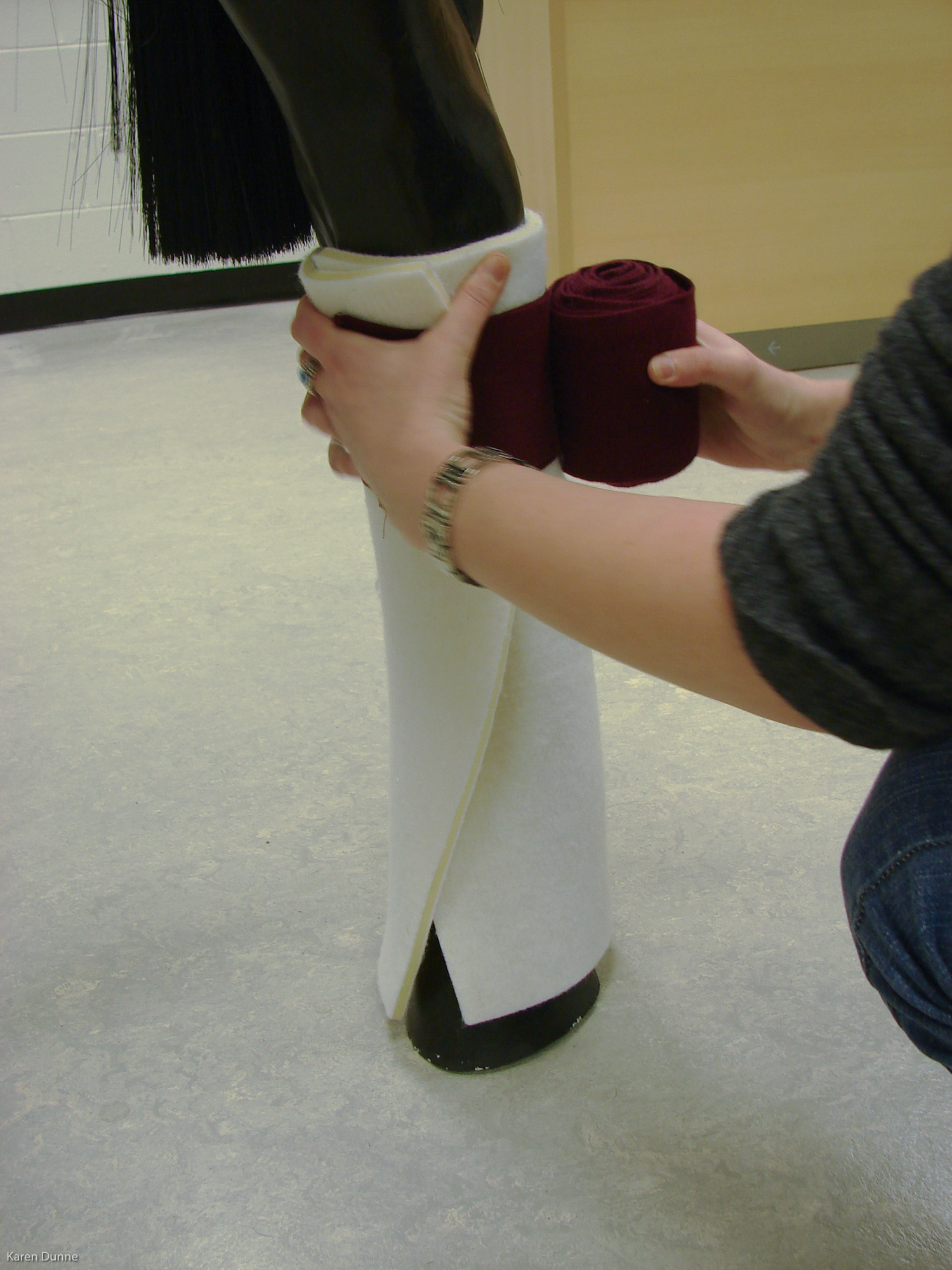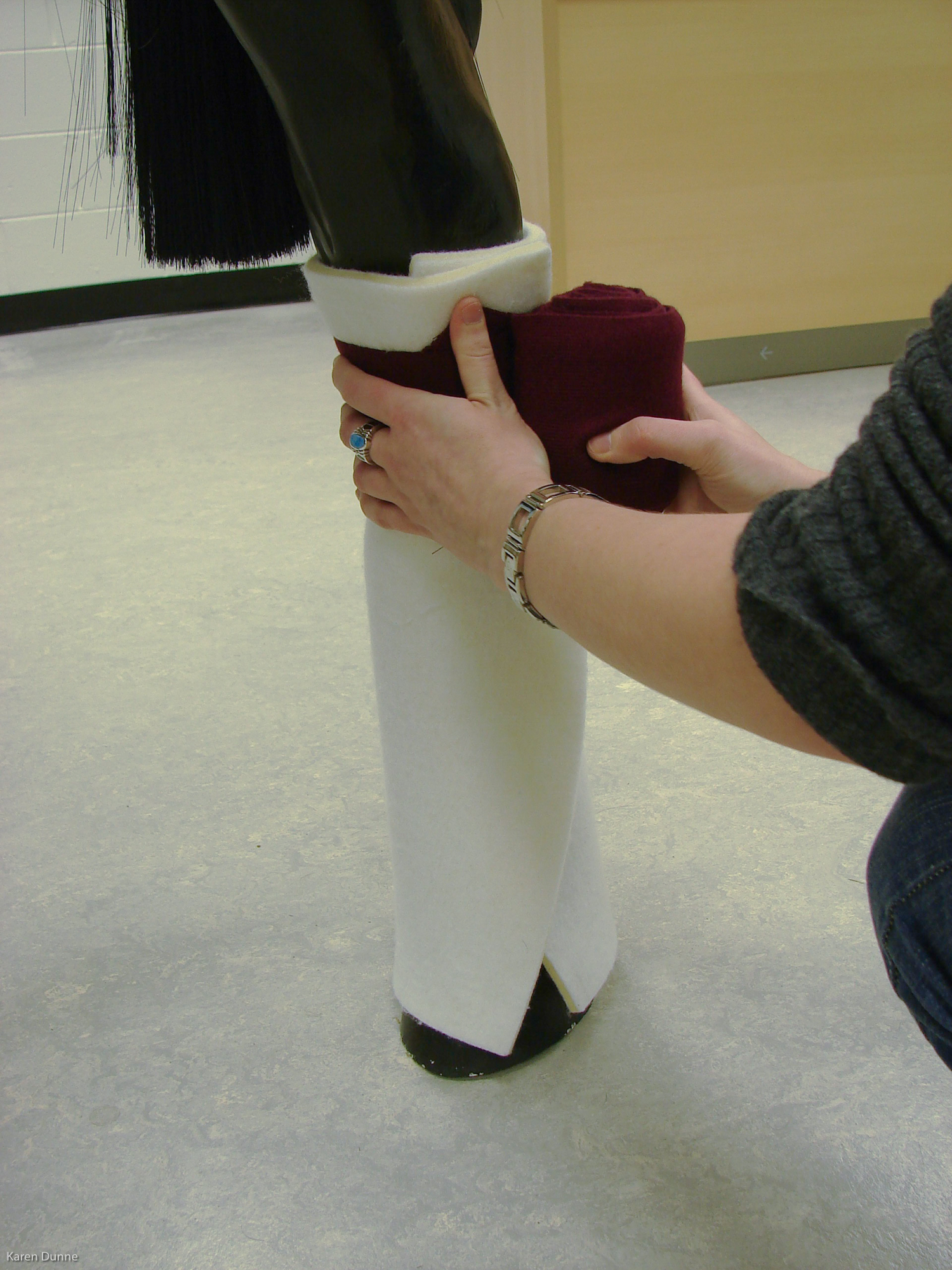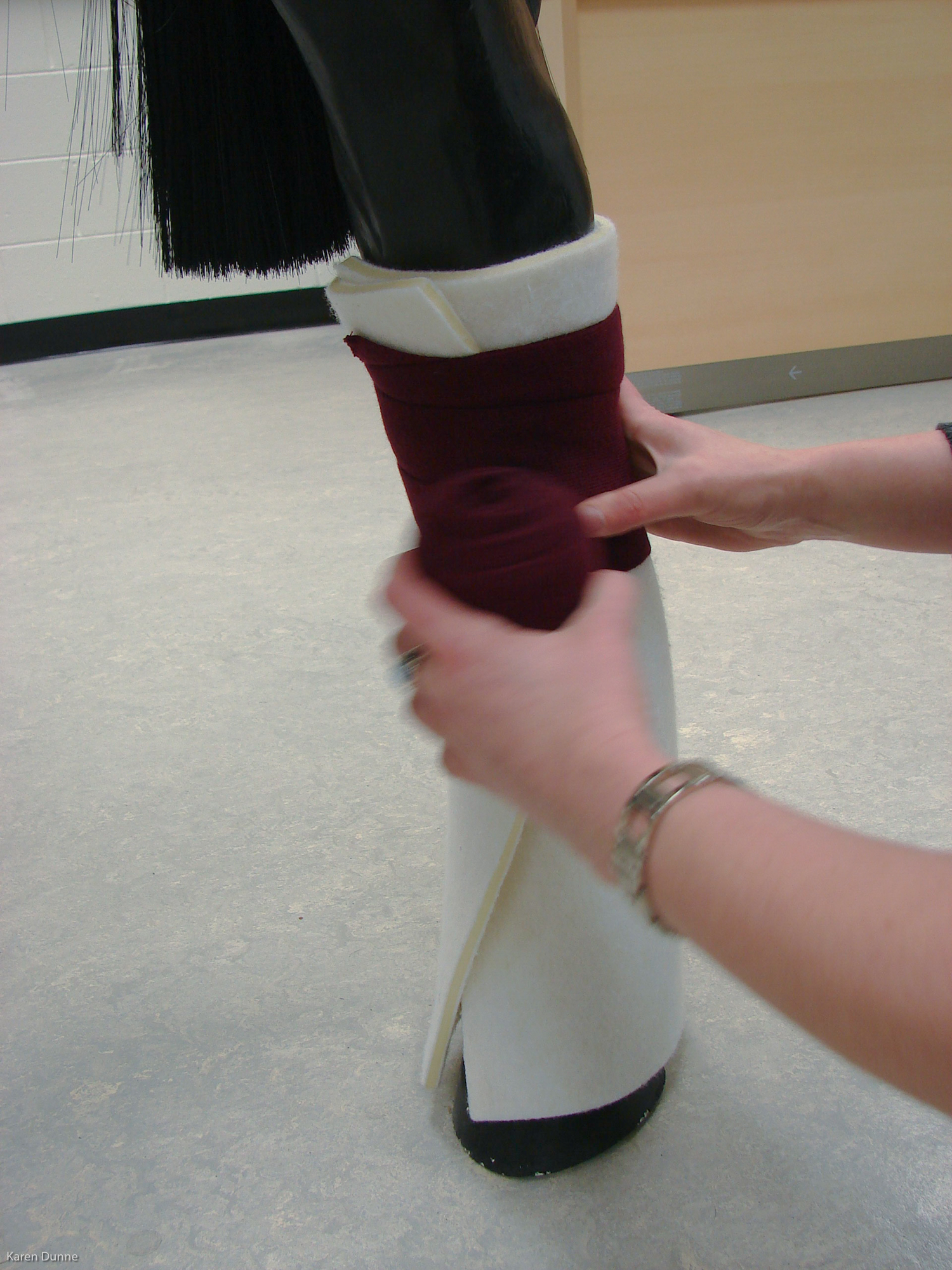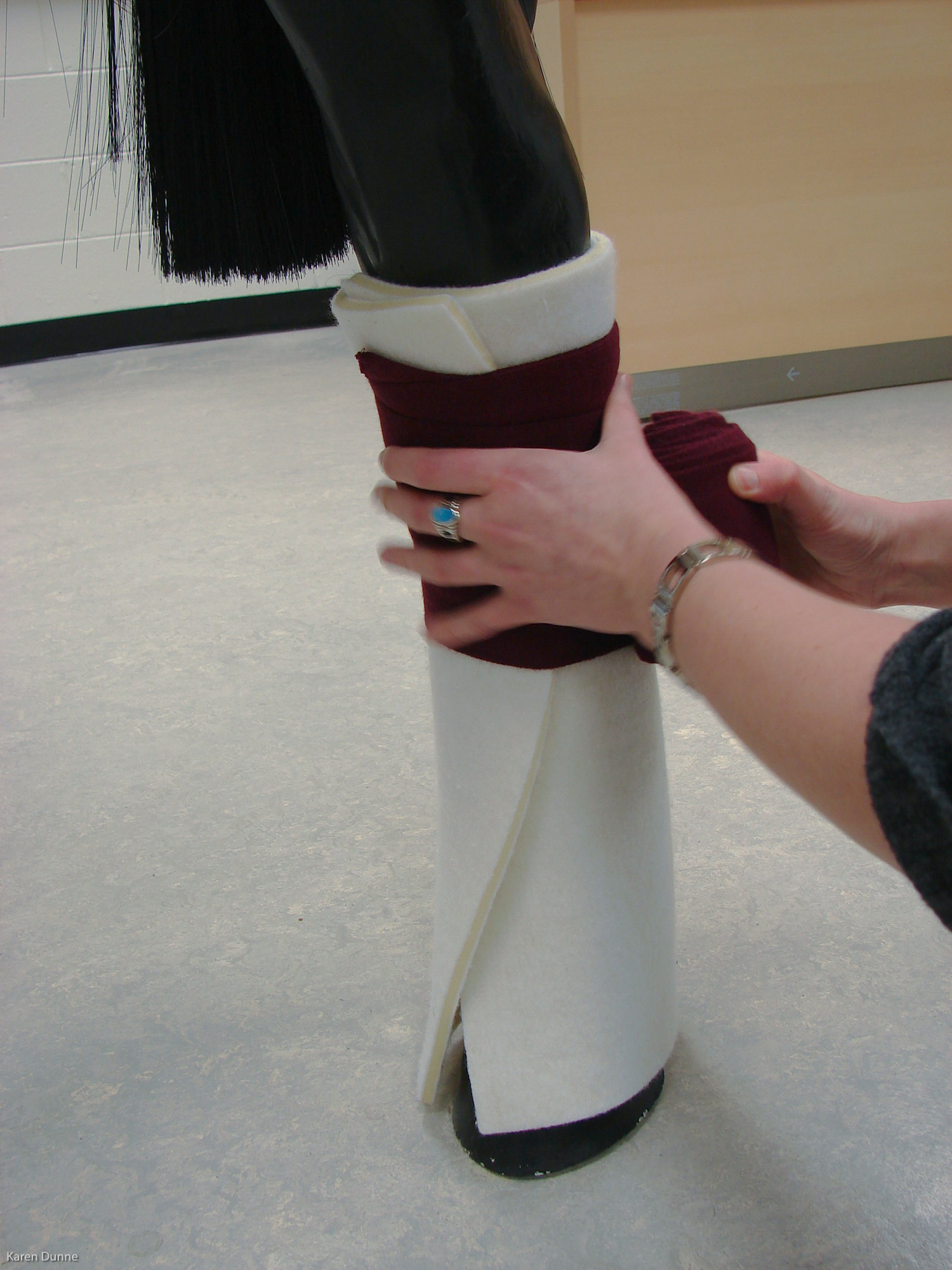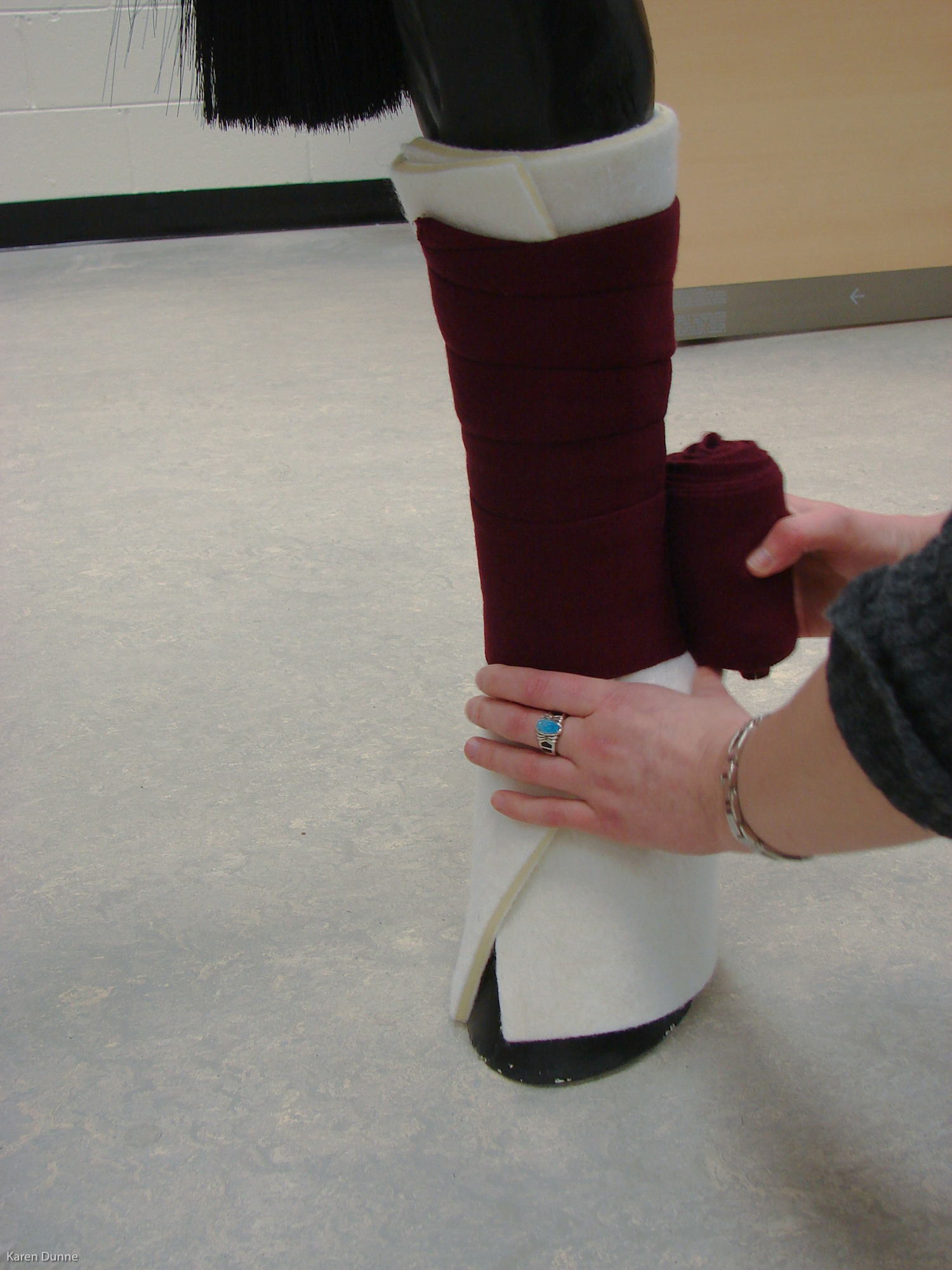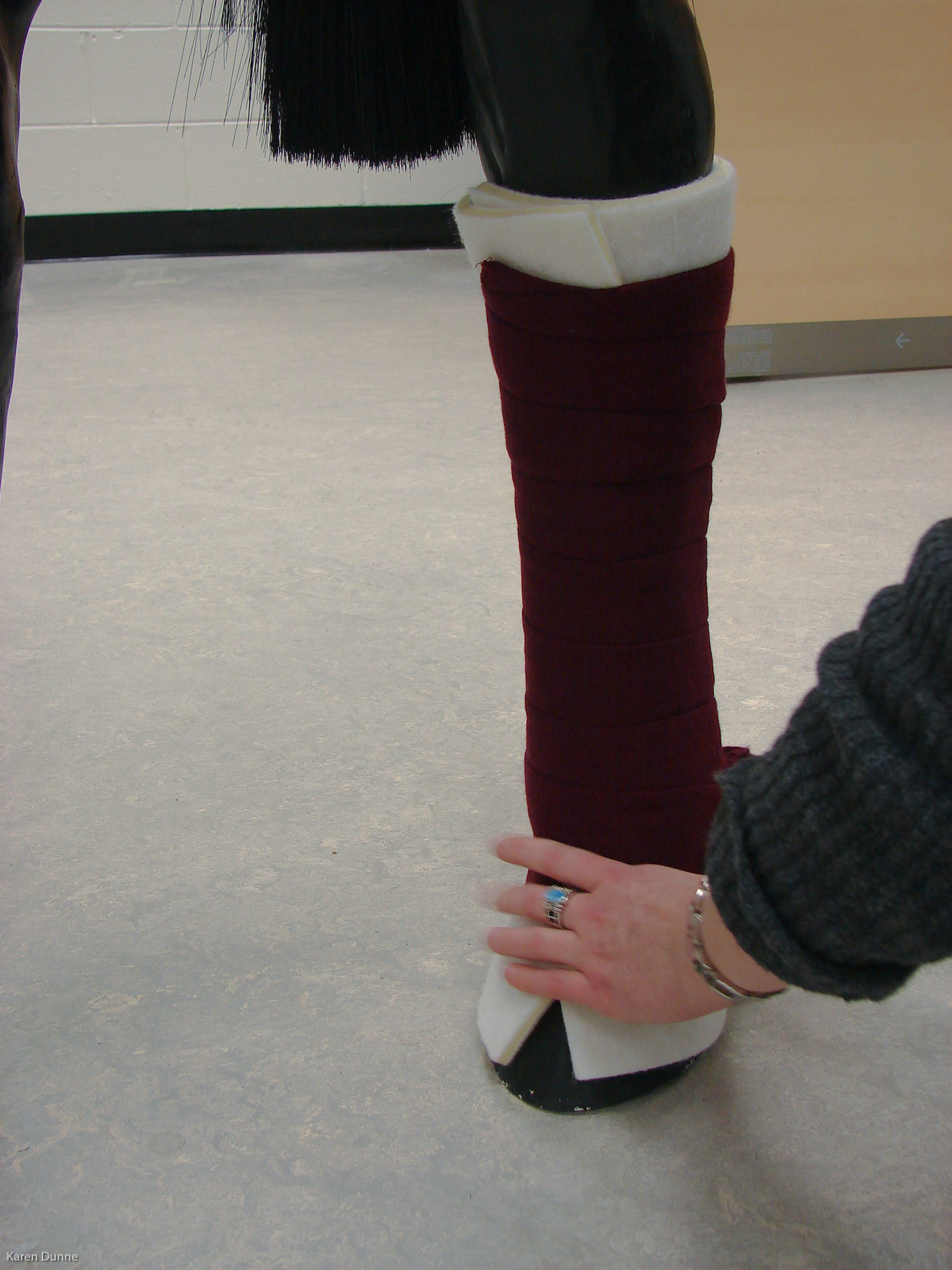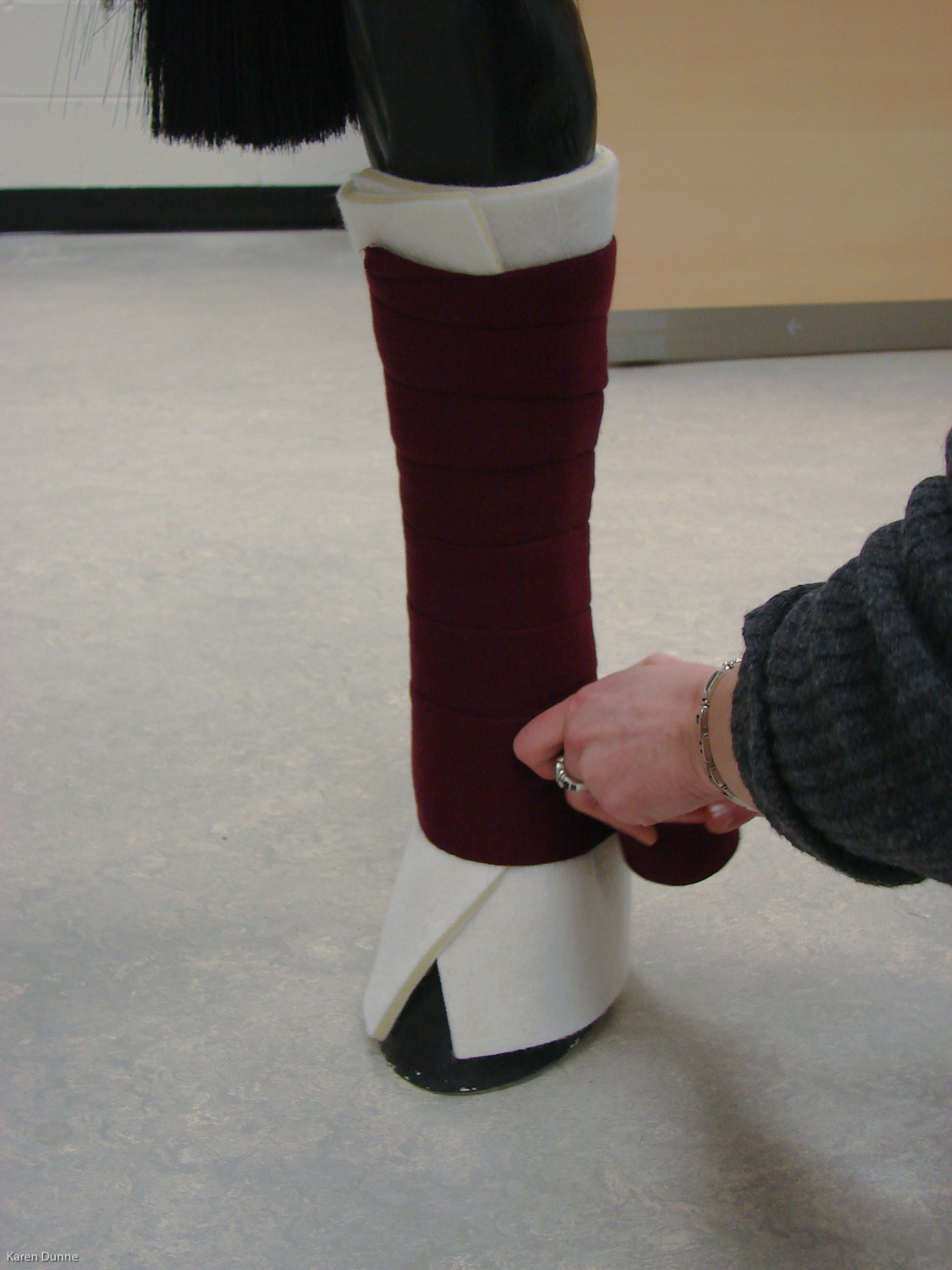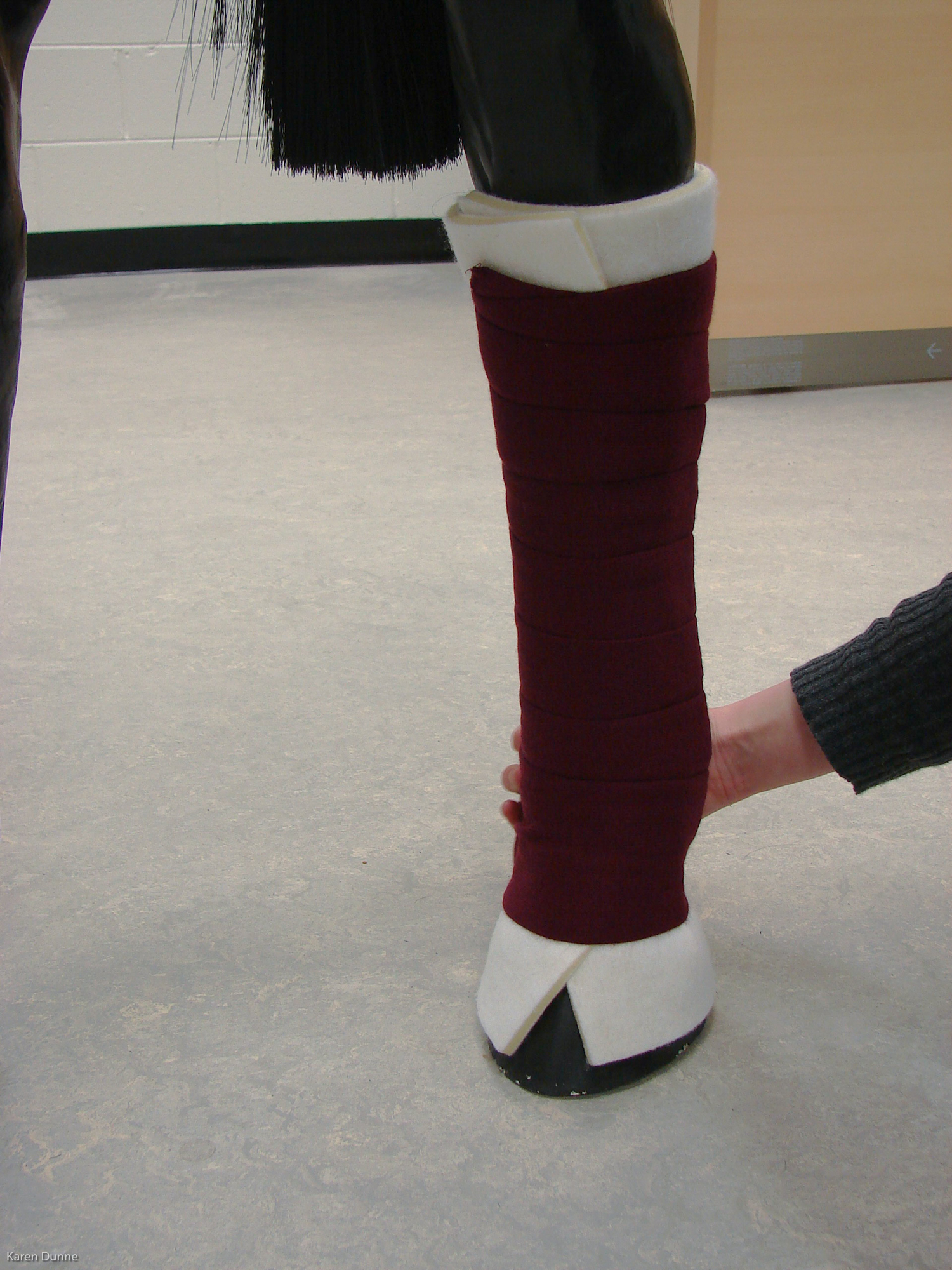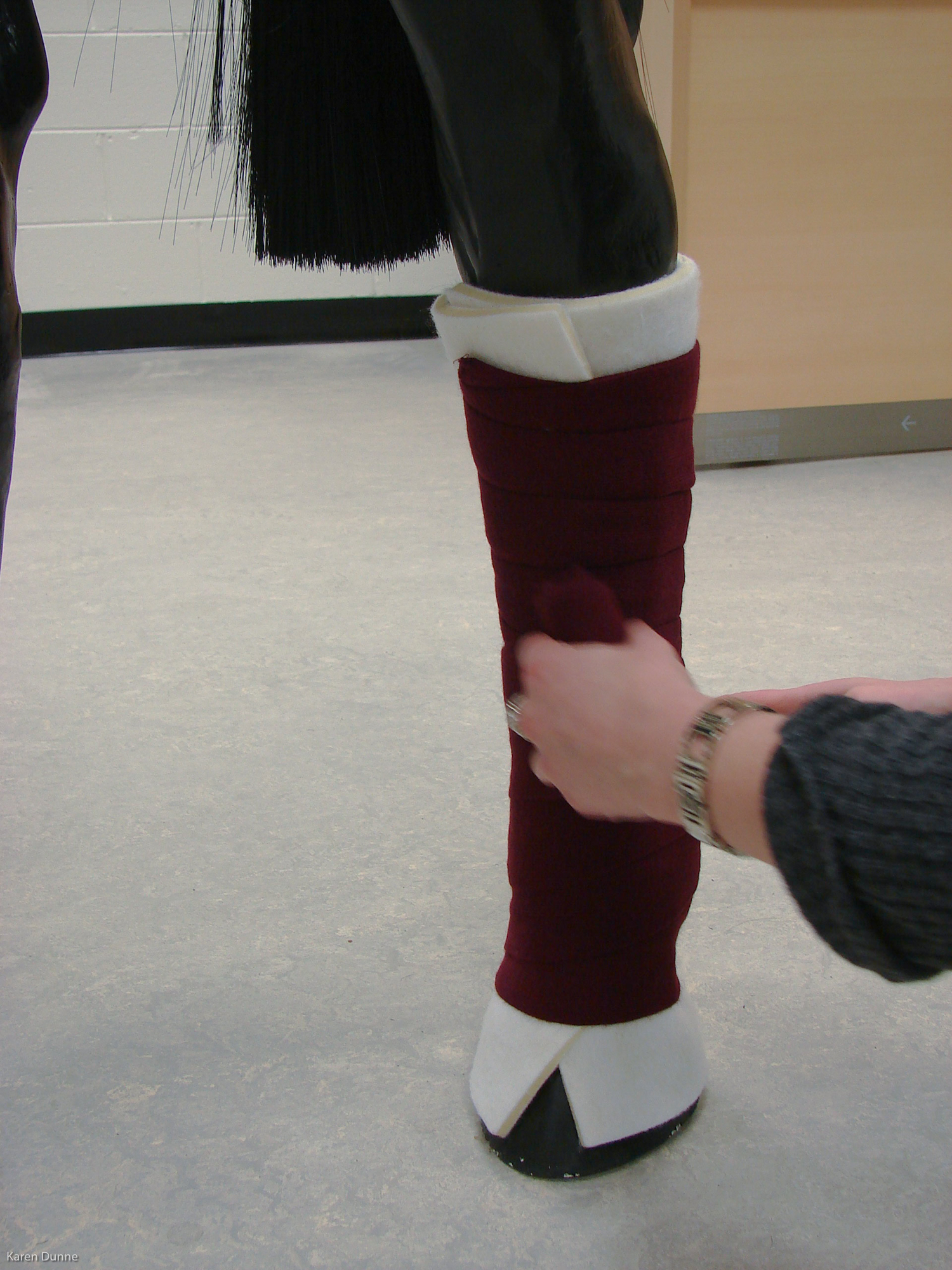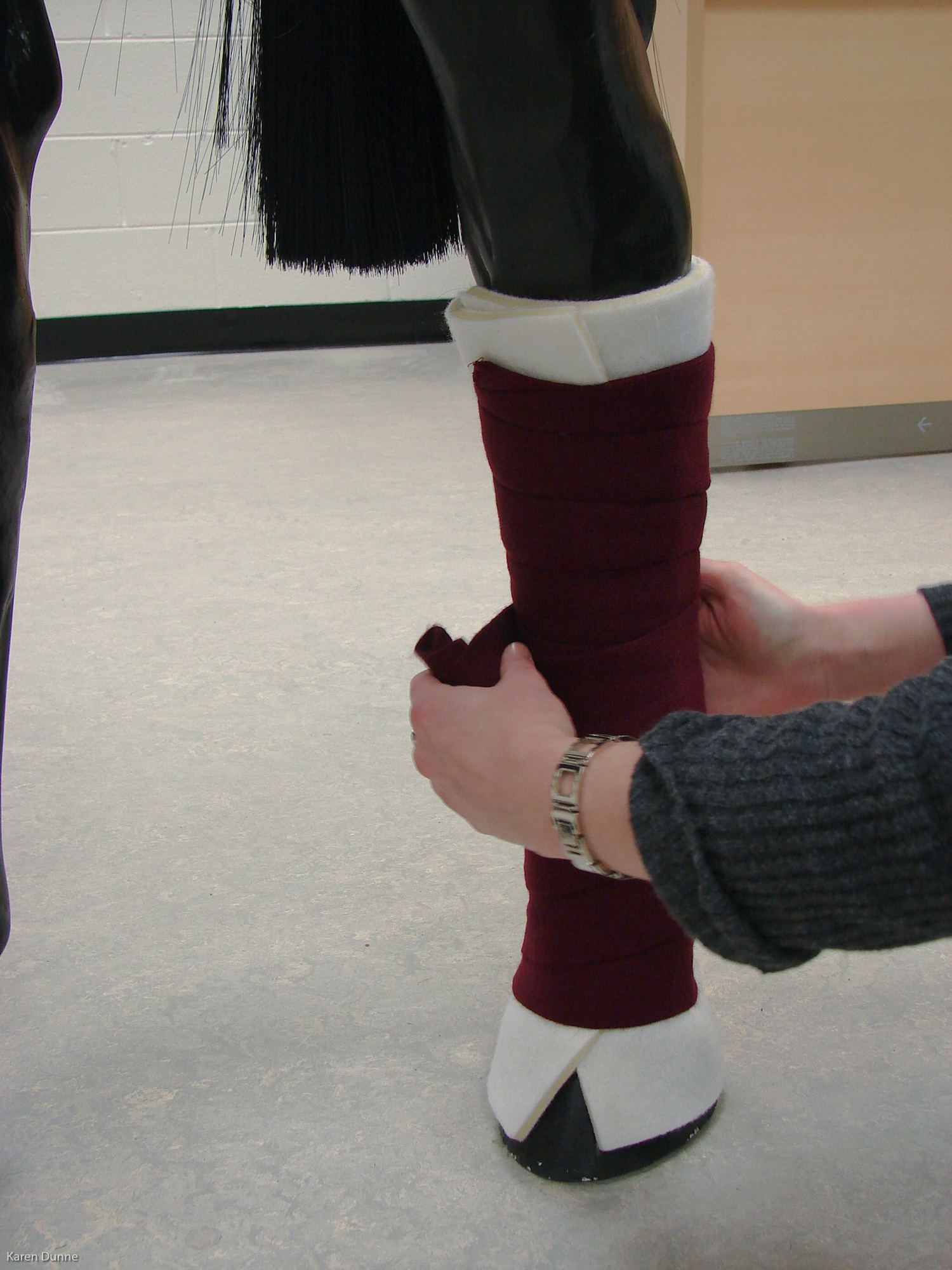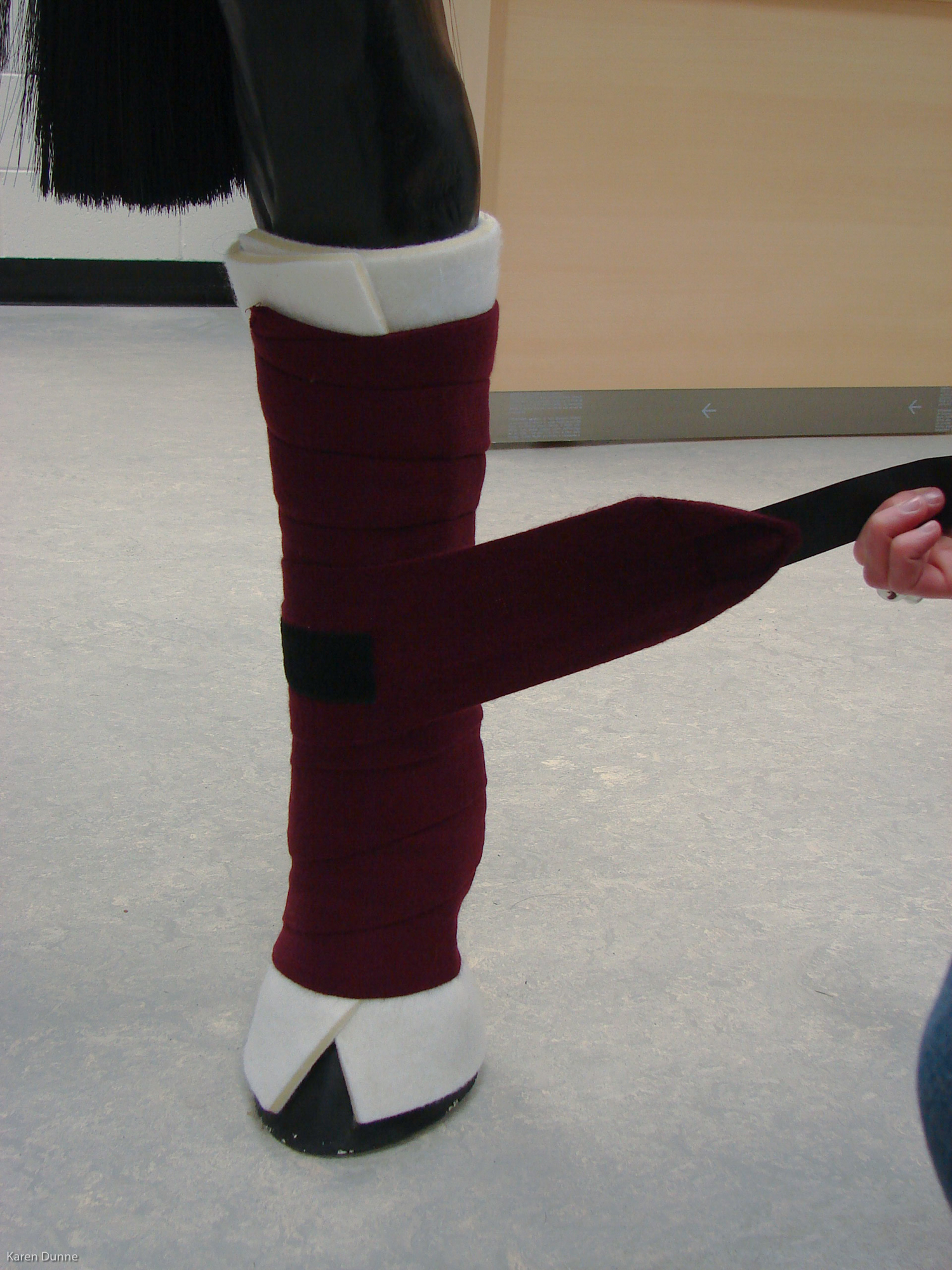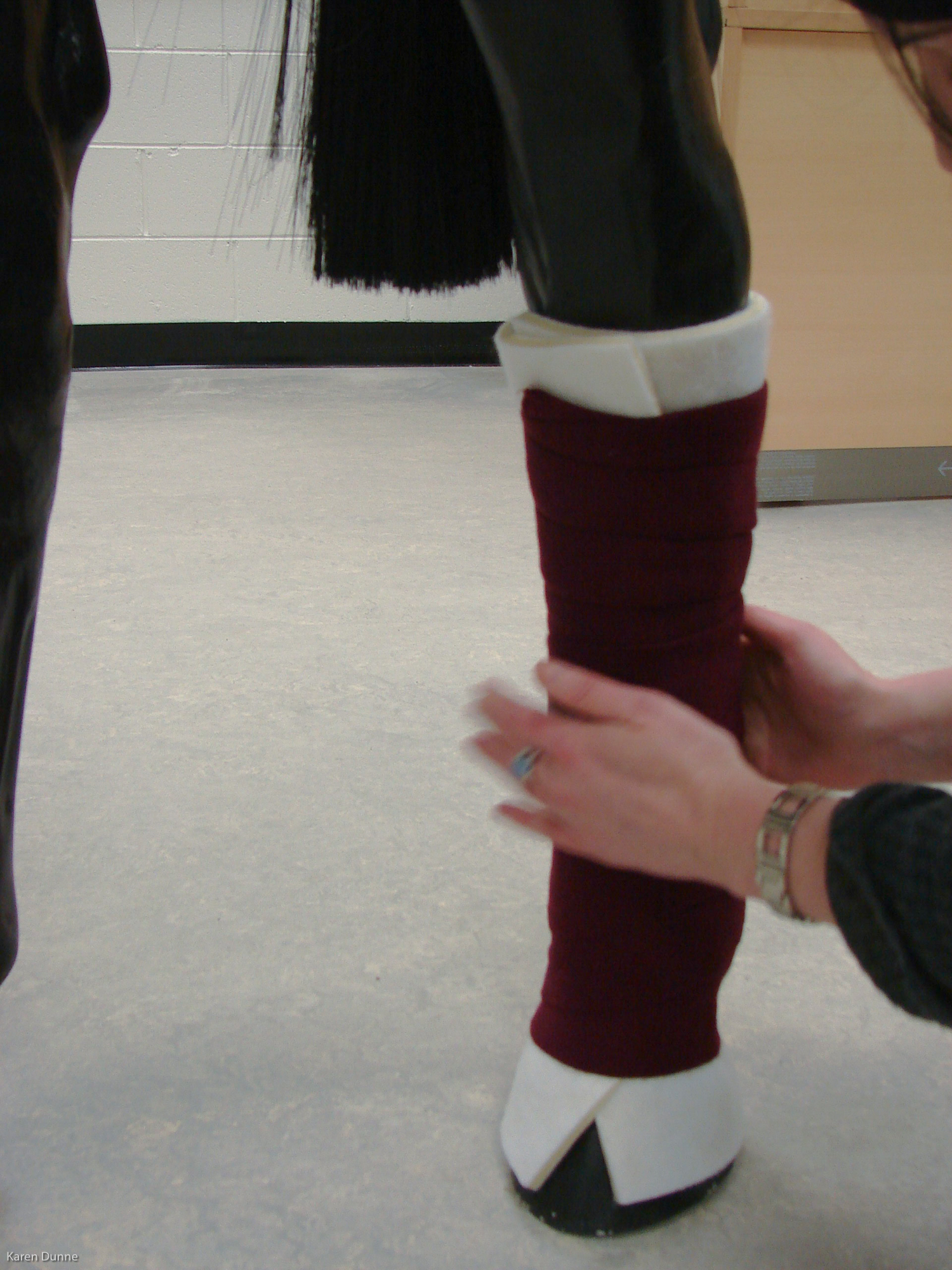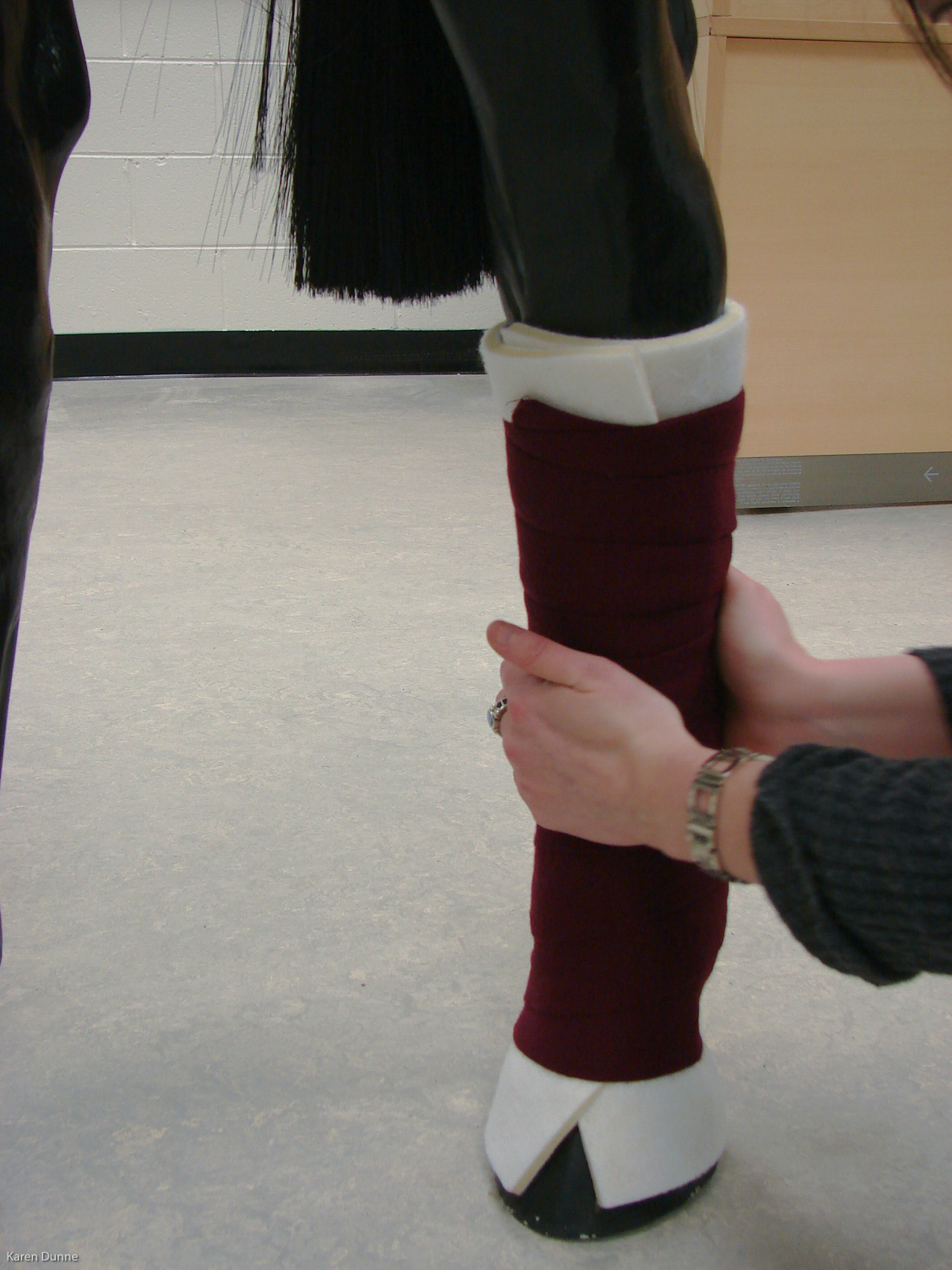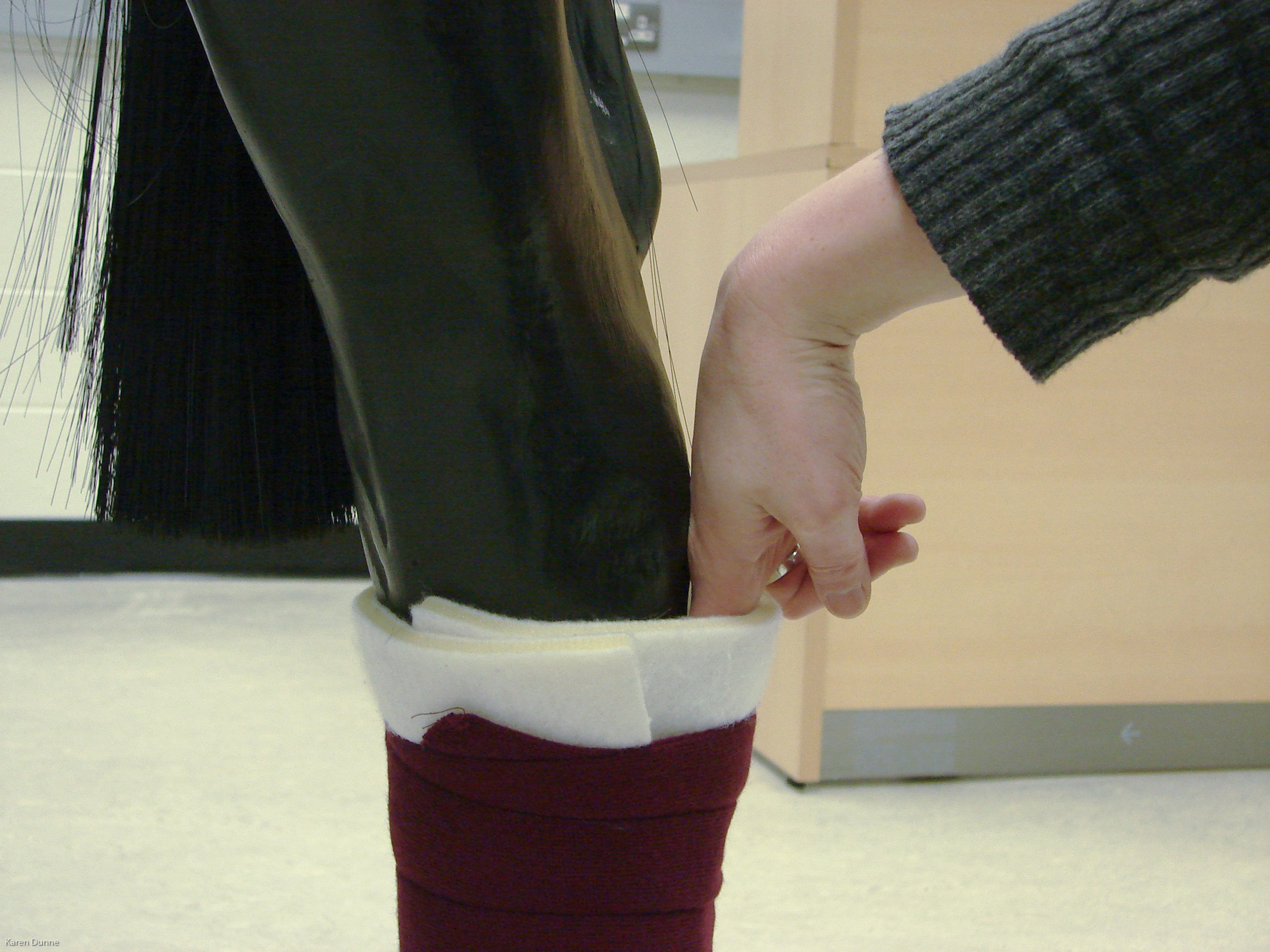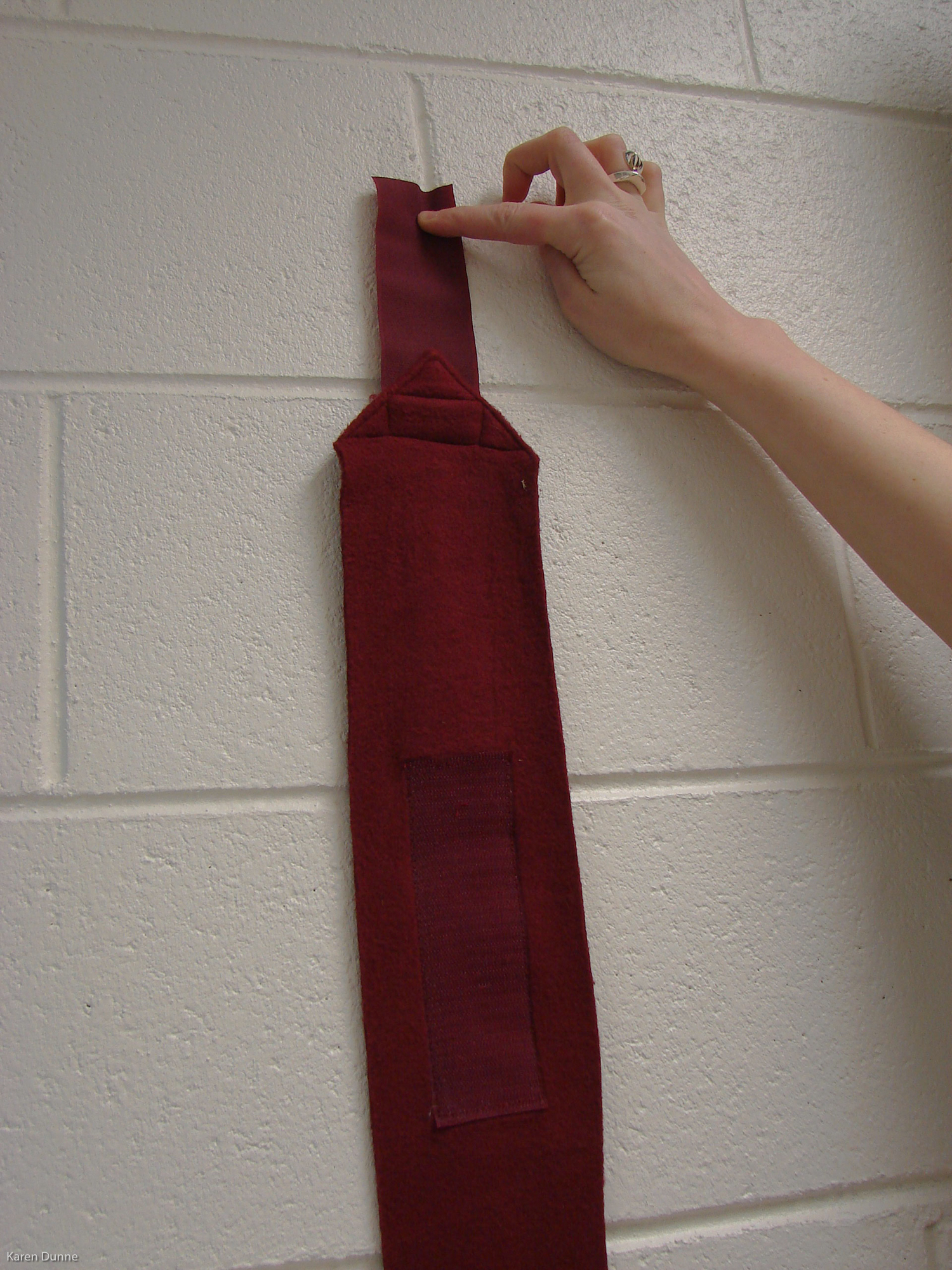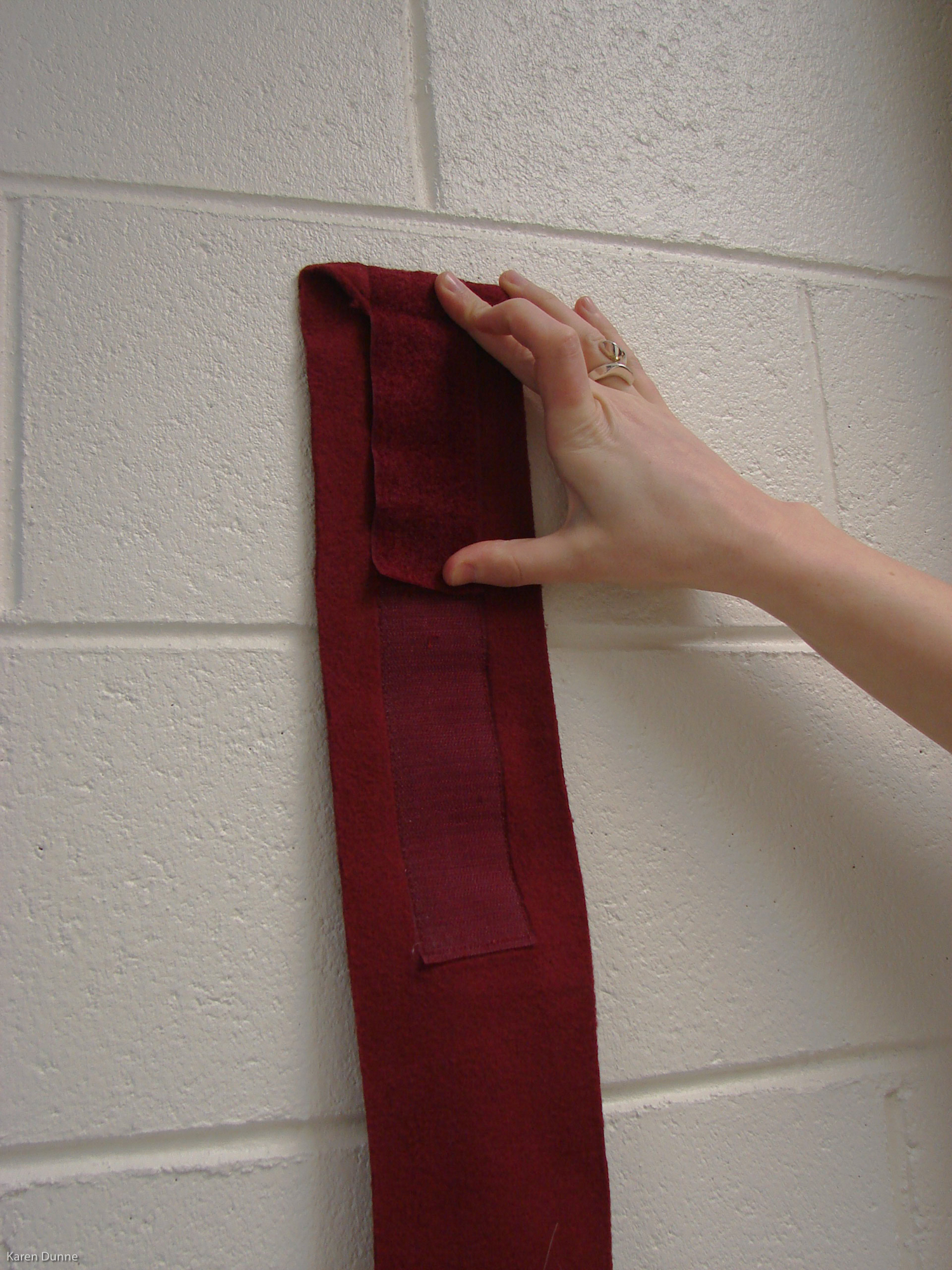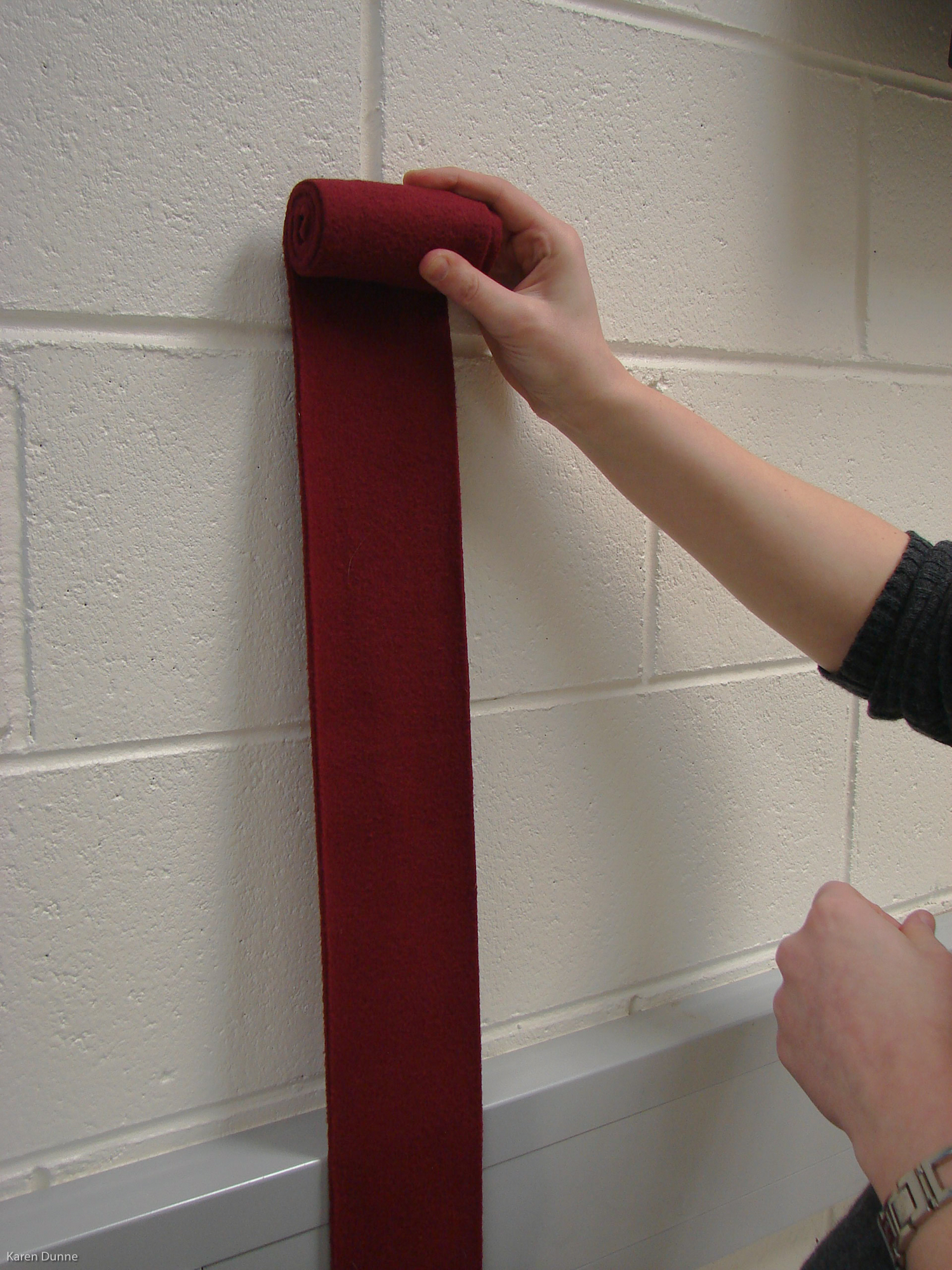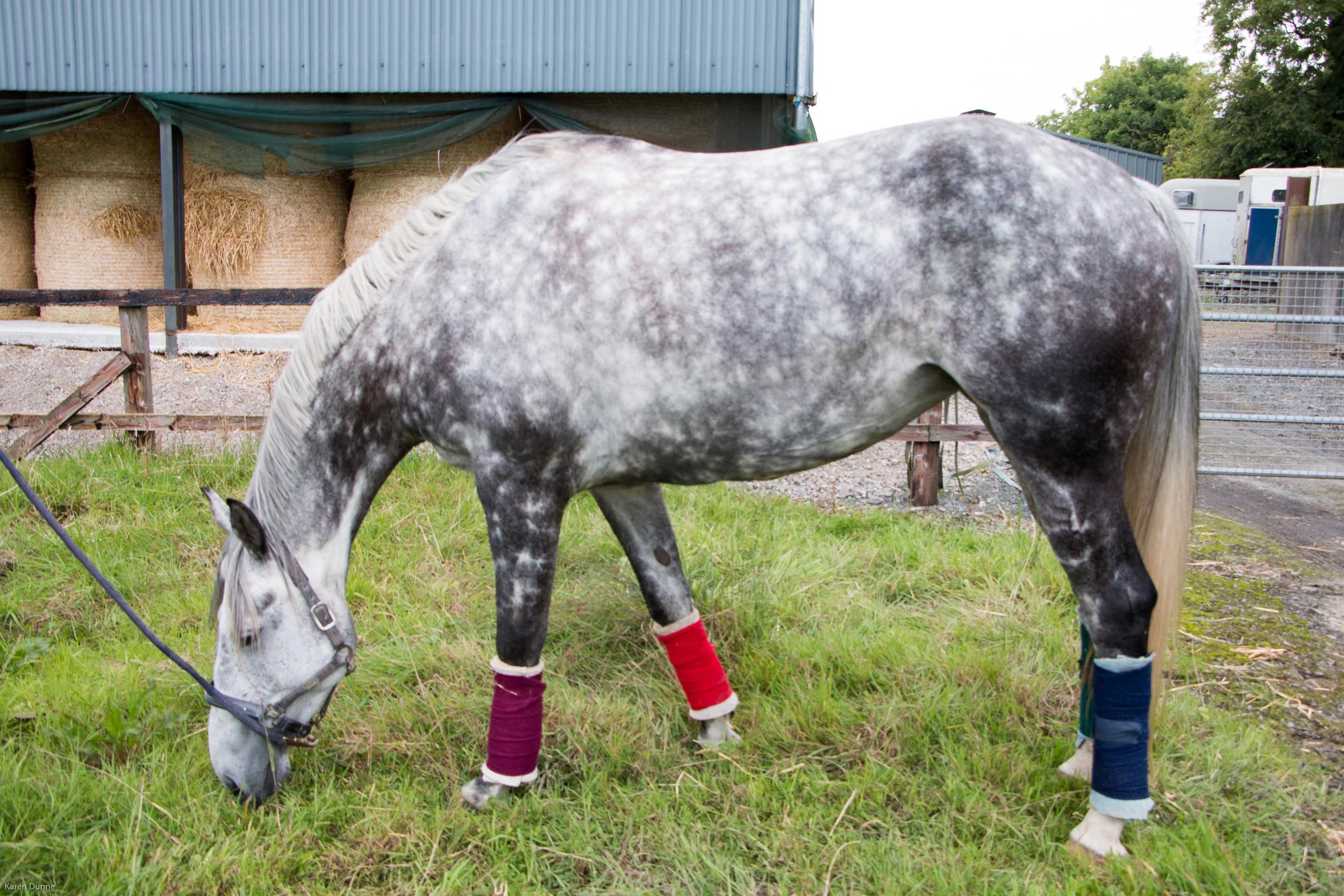Introduction
Figure 1. A fracture case (left fore) with supporting limb stable bandages and hoof pad.
Stable bandages (sometimes called "leg wraps") are applied to horses' limbs for four main reasons:
- Support
- Warmth
- Prevention of swelling
- Protection
Hospitalised horses may benefit from the additional warmth and comfort provided by stable bandages. They also protect the lower limbs from bruising, especially if the horse is recumbent or lying down more than normal due to pain or illness. Painful horses may overload the supporting limb(s) and a supportive bandage may improve patient comfort (figure 1). Horses on box rest are also prone to oedema of the lower limbs ("stocking up") and stable bandages can reduce or prevent this.
Figure 2. A nasty pressure sore caused by a too-tight bandage.
Stable bandages are not normally used for wound management or limb immobilisation, refer to external coaptation (clinical bandages, casts and splints) for these indications. However, as for any bandage, stable bandages must have sufficient padding and be applied correctly to avoid complications such as pressure sores, necrosis, soft tissue damage and scarring (figure 2).
How far down the leg should the bandage/padding extend?
Figure 3. Traditional stable bandages - note exposed pasterns.
It depends on what the bandage is intended to do! Exercise wraps (sometimes applied without padding) stop at the distal fetlock to avoid restricting limb motion. Traditional stable bandages stop at the pastern (figure 3) while those applied for travel extend on to the hoof wall to protect the coronet in case the horse treads on itself.
Sick/injured horses may lie down more than normal and for that reason it's recommended that the padding extends over the coronet to protect it from bruising by the opposite hoof/shoe. The instructions on this page therefore describe stable bandages where the padding extends onto the hoof wall and the bandage reaches the coronet.
Materials
Stable bandages:
These bandages (figure 4) are designed to be reusable and so are washable. They are made of soft, non-stretch material (3-4m in length) or fleece (3m) and have velcro fastenings. Dark colours are preferable as they don't stain as readily. Those made of fleece material are sometimes referred to as polo bandages or standing wraps.
Figure 4. Selection of stable bandages (all non-stretch, reusable & washable)
Figure 5. Quilted and fybagee padding
Padding:
A variety of padding materials can be used. These include fybagee (commercial, reusable padding material in squares that can be cut to size if necessary) and quilted pads (figure 5). Gamgee (cotton wool and gauze) can be cut to size from a roll but is not washable or very durable. Cotton wool is best avoided as it sticks to the bandages and is inclined to work its way loose.
preparation
Ensure the horse is adequately restrained, in most cases this will consist of a head collar and lead rope and the horse either tied up or held by an assistant. Work in a well lit area on a clean, dry floor. If in a stable push the bedding away from the limb and avoid leaving the materials on the ground, as bedding will stick to them.
N.B. always crouch, never kneel down! If your weight is on your knee(s) you won't be able to react quickly enough to get out of the way should the horse suddenly move.
Both the bandage and the padding should be clean, dry and intact. Ensure that the bandage has been correctly rolled up, so that the velcro fastening will be on the correct side at the end - see video one below.
Application
A stable bandage should extend from the proximal metacarpus/metatarsus to the coronet. The bandage should not extend beyond the edges of the padding. It is important that the bandage does not extend onto the carpus or tarsus as this will limit the ability of the horse to flex these joints comfortably.
Care must be taken to avoid wrinkles or creases in the padding and apply the bandage with an even tension to reduce the risk of pressure sores and other complications. The bandage should be snug enough that you can fit a finger under it but you should not be able to lift it away from the padding. Note: this is tighter than a small animal limb bandage!
If you can get the padding neatly applied and hold it in place until the bandage is securing it, you are likely to end up with a neat and functional end result. This takes practice!
Stable bandage application slideshow
Video 1. This video shows how to apply a stable bandage using fybagee padding
Video 2. This video shows how to apply a stable bandage using quilted padding
Hindlimb stable bandages are applied in a similar manner (see slideshow above). Note that the metatarsals are longer than the metacarpals so you may need a larger piece of padding. Placing a temporary knot in the end of tail reduces the likelihood of stray hairs getting caught up in the bandage.
removing stable bandages
Undo the velcro and rapidly pass the bandage from hand to hand. The aim at this point is to get it off the limb as quickly as possible (see video 1). If the horse moves at this point you will end up with the bandage trailing across the floor or getting wrapped around the horse's legs, possibly frightening it further, so don't delay. Remove the padding and run your hands down the limbs to remove any loose hair, bedding etc. and to check for any skin damage, pressure sores etc.
Re-rolling stable bandages:
Shake off any bedding etc. and roll the bandage up neatly, ensuring that the velcro fastening is stuck back onto itself and facing upwards as you do so - see images below and video 1 above. Try and keep the bandage under tension as you neatly reroll it - this will make it much easier to apply.
Stable bandages must be removed and reapplied at least daily. This ensures they remain comfortable and allow you to monitor the horse's limbs and digital pulses.
Rolling a stable bandage







Bandaging lore
Equine bandaging is as much an art as a science. Much practice is based on tradition and experience, rather than scientific evidence. This may change as more bandaging studies are conducted and published. This is not to say that tradition and experience are incorrect, but you may encounter conflicting or confusing methods in practice. Contentious issues include (but are not limited to!) should you start at the top or bottom, roll clockwise or anticlockwise and wrap tendons "in" or "out"?!
At the end of the day ask yourself "what is this bandage for?" If the bandage has been applied in such a way as to carry out its function comfortably, effectively and without harming the patient, then it is correct.
Remember that in many cases an incorrectly or poorly applied bandage is far more harmful than no bandage at all! It's therefore important that you practice this important skill until you are proficient in it.
further reading
Caston, S.S. (2012). Wound Care in Horses. Veterinary Clinics of North America - Equine Practice, 28, pp.83-100.
Holtgrew-Bohling, K. (2016). External coaptation. In: Large Animal Clinical Procedures for Veterinary Technicians. 3rd ed. St Louis: Mosby Elsevier, pp.295-305.




